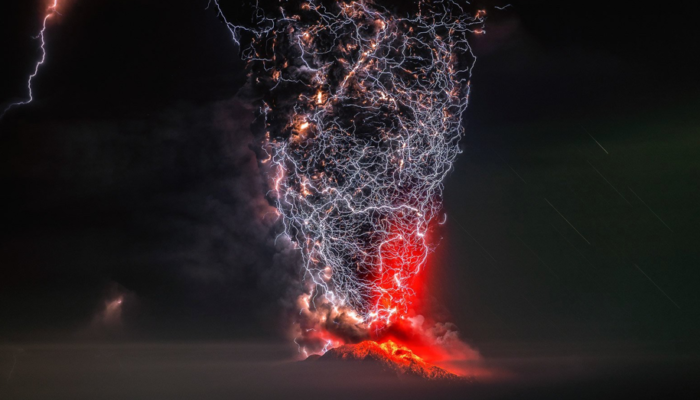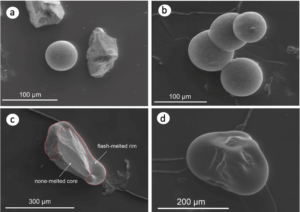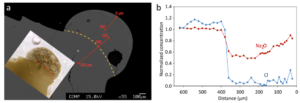
Volcanic lightning is a common phenomenon related to explosive volcanism, often rattling down in a spectacle of hundreds of lightning strikes within a single eruptive event. Apart from its spectacular appearance, lightning can also be used as helpful tool to detect and monitor volcanic activity in remote locations on Earth and potentially on other planets, and is even questioned to have influenced the formation of life on Earth. As part of the recently upcoming boom of volcanic lightning research, scientists started to question the influence of lightning on ash particles suspended in an eruptive plume and came to interesting findings, read on to learn more…
How does volcanic lightning form?
The dynamic interactions of ash particles within an eruptive plume (or pyroclastic flow) cause electrical charging and charge separation within the plume, resulting in the formation of lightning strikes. Recent observations imply that the appearance of lightning is related to the explosivity of an eruption, where more lightning is created in more explosive eruptions. On the other hand, factors like plume heights, eruption type and magma composition don’t seem to influence the occurrence of lightning (McNutt & Williams, 2010).
To see some beautiful volcanic lightning, check this out:
Some key physical parameters
As we all know, thunderstorm lightning is a fairly hazardous natural phenomenon and is able to cause significant damage wherever it hits the ground. But how does this compare to volcanic lightning? On a first view it seems as volcanic lightning is a miniature version of thunderstorm lightning: the maximum currents reached for volcanic lightning are 2 kA compared to 30 kA reached by a grown-up thunderstorm lightning strike. Also its duration is significantly shorter, having an average appearance of 0.1-8 ms compared to 200 – 300 ms for thunderstorm lightning. But nevertheless, temperatures reached by volcanic lightning are as high as in thunderstorm lightning strikes (12.000 – 28.000 K in the discharges centre). These high temperatures obviously have enough potential to significantly affect ash particles suspended in volcanic plumes (Genareau et al., 2015; Aizawa et al., 2016; Wadsworth et al., 2017).
Potatoes and spheres – Morphological modification of ash particles
Based on a newly developed experimental setup, we were able to recreate the conditions of lightning discharges in the lab using an arc welding machine to investigate the influences of lightning strikes on ash particles.

Morphology of experimentally produced lightning-affected particles (LAP) from natural ash (Sakurajima volcano, Japan). (a) entirely re-melted, spherical particle (Type III), and pristine ash particles (Type I); (b) agglomerate of spherical LAPs (Type IV); (c,d) partially melted particles with a non-melted core (modified after Mueller et al., 2018).
Based on those experiments, four different particle types were distinguished based on the degree of lightning-interaction:
Type I – particles, that did not undergo lightning-interaction (image a).
Type II – Partially melted particles, comprising of grains that did interact with the lightning strike but not sufficient enough to melt the entire grain, displayed by either leftovers of pristine surface or irregular shapes of the particle (c,d).
Type III – Completely melted particles, which are particles that were entirely melted and typically appear in a spherical shape (a).
Type IV – Aggregates, being clusters of up to four amalgamated particles of different types (b).
Have you ever seen a boiling ash particle? Physical processes behind lightning interaction
To form these particle shapes, several different physical processes must work together as observed in high-speed video recordings of lightning-interaction. These processes include simple particle rounding associated with melting of the particle and collision of particles but also vesiculation and foaming of particles (see the video), fragmentation and complete vaporization of particles due to increased heating of the particle during passage of the discharge channel.
Are particles also chemically altered?

(a) Particle from a stationary experiment. Interaction with plasma arc led to melting and rounding of the upper edge, separated by the dashed yellow line from the less affected core. Inlay shows photomicrograph of the same particle with abundant bubbles formed as the droplet boiled. (b) Concentration profile from the core into the droplet showing a concentration gradient indicative of diffusion of Na (modified after Mueller et al., 2018)
Based on electron microprobe measurements we were able to detect a pronounced loss of volatile elements in lightning-affected particles showing clear depletion of Na < P and S < Cl <F. We recognised that volatile element distribution within single grains is not homogeneous with no to very little directional trends. We explain this to be the result from a combination of 1) thermal volatilization, 2) convective transport due to strong vesiculation, and 3) chemical diffusion induced by the high temperatures of lightning.
To finally unravel the mystery of temperatures experienced by lightning affected particles, we modelled the thermal history of single grains based on the degree of Na volatilization revealing temperatures in the range of 3290 to 3490 K.
References
- Aizawa, K., Cimarelli, C., Alatorre-Ibargüengoitia, M. A., Yokoo, A., Dingwell, D. B., & Iguchi, M. (2016). Physical properties of volcanic lightning: Constraints from magnetotelluric and video observations at Sakurajima volcano, Japan. Earth and Planetary Science Letters, 444, 45-55.
- Genareau, K., Wardman, J. B., Wilson, T. M., McNutt, S. R., & Izbekov, P. (2015). Lightning-induced volcanic spherules. Geology, 43(4), 319-322.
- McNutt, S. R., & Williams, E. R. (2010). Volcanic lightning: global observations and constraints on source mechanisms. Bulletin of Volcanology, 72(10), 1153-1167.
- Mueller, S. P., Helo, C., Keller, F., Taddeucci, J., & Castro, J. M. (2018). First experimental observations on melting and chemical modification of volcanic ash during lightning interaction. Scientific reports, 8(1), 1-9.
- Wadsworth, F. B., Vasseur, J., Llewellin, E. W., Genareau, K., Cimarelli, C., & Dingwell, D. B. (2017). Size limits for rounding of volcanic ash particles heated by lightning. Journal of Geophysical Research: Solid Earth, 122(3), 1977-1989.

Pingback: Geochemistry, Mineralogy, Petrology & Volcanology | An Overview on the 15 Jan 2022 Hunga Tonga-Huna Ha’apai Eruption